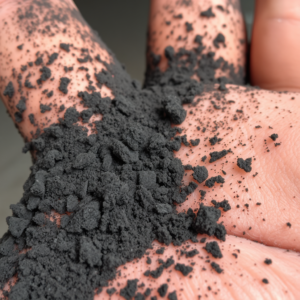
After a fire, one of the most striking remnants in your home is the layer of soot clinging to walls, ceilings, and furniture—a dark, powdery reminder of what happened. This residue, known as soot, is not just a visual reminder of the damage—it’s a challenge to remove and a potential health hazard. For homeowners asking, “What does soot look like?” understanding the appearance, type, and dangers of this is an important first step to restoring your home and making it habitable again.
Soot is not mere dirt or ash. It’s a very fine residue of carbon that is produced mostly from an incomplete burning of materials. Whether you are preparing to sell fire-damaged property or planning for remodeling the house after a fire, it is important to know what soot is, how it behaves, and the best ways to manage it, because soot can easily spread from room to room. This guide will help you understand how to spot and handle soot properly, so your home stays clean, safe, and ready for whatever comes next.
Ever Wondered What Soot Really Looks Like?
Soot manifests in many different forms, including the materials and burn severity. In essence, soot is a black, brown, or gray powdery mass of tiny carbon particles. It can manifest itself in many textures and consistencies, making it annoying to clean up. Identification of soot is willingly accompanied by an understanding of its unique characteristics:
Key Characteristics of Soot
1. Color
Soot, based on the materials burned, may range from deep black to light gray or brown. For example:
- Black & Sticky: Leaving a sticky residue very often as a result of grease fire, burnt plastics or synthetic materials.
- Gray & Powdery: Common after wood fires, resembling fine ash.
- Brown Streaks: Sometimes left by burnt textiles or organic matter.
2. Texture
Soot is generally flaky or powdery, and it becomes easily smeared with touch. But, some conditions when plastics, cooking fats, or synthetics burned, it can feel oily and clingy, which makes cleaning difficult.
3. Spread
One of the most difficult aspects of soot is the extent of its dispersion. It settles almost everywhere: on surfaces visible to the eyes-such as walls and ceilings-and also:
- Inside ventilation systems.
- Beneath furniture and carpets.
- Within small crevices and corners.
In fact, soot is really a common concern, particularly for anyone who would really prefer eminent selling a house damaged by fire or going through renovations.
How Different Fires Shape the Look of Soot
The type of fire plays a crucial role in determining what soot looks like:
- Kitchen or Grease Fires: It emits a very strong, unpleasant odor and stains blackened, sticky surfaces and most of the time, adheres to countertops and cabinets adjacent to them.
- Wood or Paper Fires: A fine dust or powdery gray or white residue that resembles typical ash. It usually settles out uniformly over surfaces.
- Synthetic Fires: Smoke created due to the burning of plastics or textiles is oily in nature and produces very dense soot that smears easily, forming dark streaky stains.
When assessing a fire-damaged house, looking at the type of soot left behind can help you identify the materials burned and guide you toward the proper cleaning methods.
What Makes Soot So Dangerous?
Recognizing what soot looks like is important, but understanding its dangers is even more critical. Soot is not simply a cosmetic nuisance—it’s a mix of harmful chemical compounds and fine particles that pose risks to both health and property.
Health Hazards of Soot Exposure
1. Respiratory Issues
Breathing soot particles may irritate the lungs, resulting in coughing, shortness of breath, or asthma attacks. Long-term exposure to soot has been found to cause life-threatening conditions such as:
- Lung cancer.
- Cardiovascular diseases.
2. Skin Reactions
When soot comes in direct contact with the skin, it can be irritating and lead to skin rashes or even allergic reactions. Individuals who have sensitive skins or have preexisting conditions are at greater risks of suffering from these conditions.
3. Toxic Compounds
Burning materials like plastics or commercial-grade chemicals can release toxic compounds into the atmosphere, potentially lingering in the soot. Prolonged exposure to these compounds can have significant health effects.
Damage to Property
Soot is acidic in nature, making it highly corrosive. If left untreated, it can:
- Etch into glass surfaces, leaving permanent damage.
- Corrode metal fixtures, such as faucets and pipes.
- They include stains that are permanent on walls, ceilings, and furniture.
For someone planning how to remodel their home after a fire, addressing soot promptly is pivotal to preserving the structural integrity of the property.
 Tips and Tricks for Tackling Soot Cleanup
Tips and Tricks for Tackling Soot Cleanup
To effectively manage soot cleanup, it’s essential to first understand what does soot look like—it typically appears as a black, powdery or flaky residue, often found after incomplete combustion or fire damage. If the soot damage is minimal, begin by wearing protective gear such as gloves, a face mask, and eyewear to avoid health risks. Next, ventilate the area by opening windows and doors. Use a chemical sponge to lift soot from walls and ceilings without causing smearing. For carpets and soft furnishings, vacuum with a HEPA-filtered vacuum to capture fine soot particles. On hard surfaces like floors and counters, scrub the soot with a trisodium phosphate (TSP) solution mixed with water.
What does soot look like, and why is it a concern? Beyond being a sign of fire damage, soot poses both a health hazard and a property risk that demands immediate action. Gaining a solid understanding of its appearance, behavior, and removal techniques can better prepare you to restore your space. Whether you’re cleaning to renovate or prepare for a sale, addressing soot promptly is key to achieving a safer, cleaner, and more inviting home.


